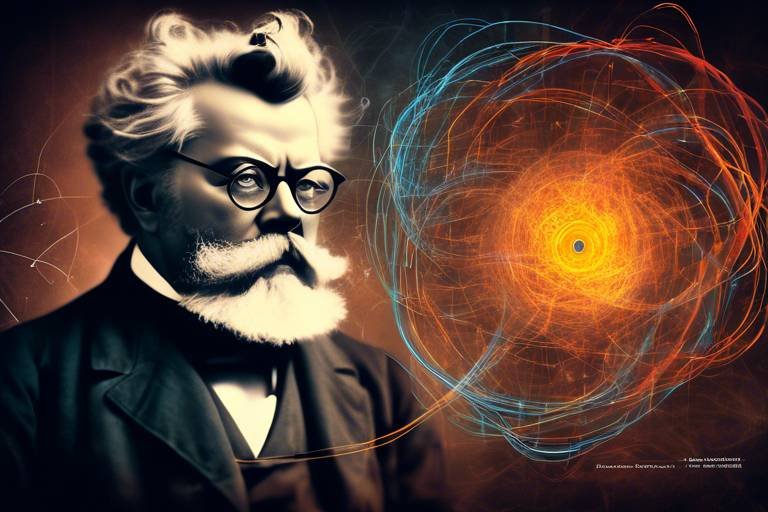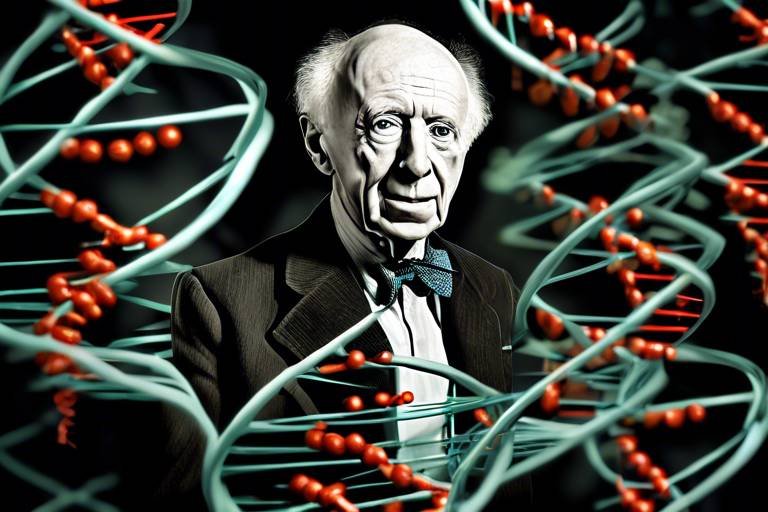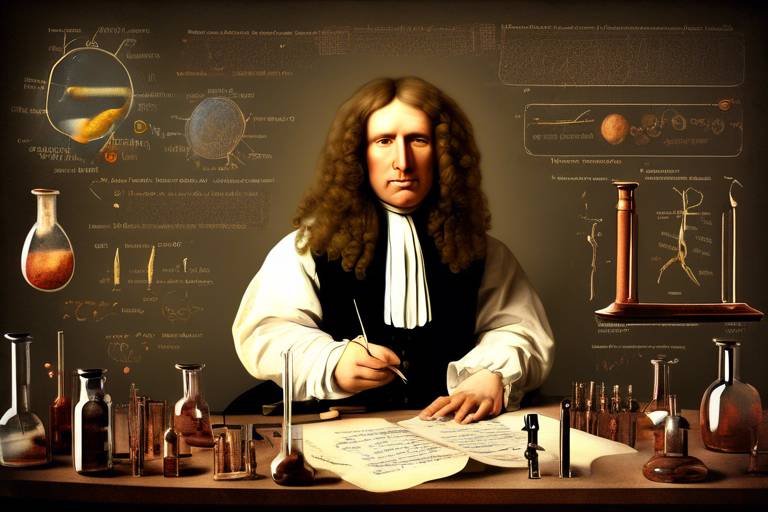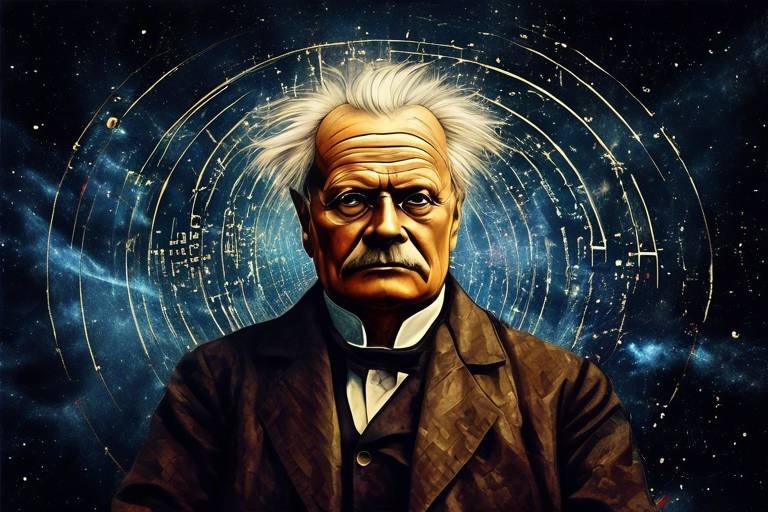The Contributions of Ludwig Boltzmann to Thermodynamics
Ludwig Boltzmann, an Austrian physicist, is often regarded as one of the pivotal figures in the development of modern physics, particularly in the realm of thermodynamics. His groundbreaking ideas and theories have reshaped our understanding of how microscopic behaviors of particles relate to macroscopic properties of matter. Imagine trying to understand a bustling city by observing just a few individuals; that's essentially what Boltzmann did for the world of physics. He bridged the gap between the tiny particles that make up matter and the larger, observable phenomena we experience every day. This article delves into his significant contributions, focusing on his development of statistical mechanics, the formulation of the Boltzmann equation, and his insights into entropy and the second law of thermodynamics.
Boltzmann's work laid the foundation for statistical mechanics, a field that connects the dots between the microscopic world of atoms and molecules and the macroscopic world we can see and measure. Before Boltzmann, thermodynamics was primarily understood through empirical laws, but his theories introduced a new perspective. He proposed that the properties of gases and other systems could be explained by the statistical behavior of their constituent particles. This was a revolutionary idea at the time, as it suggested that the chaotic motion of countless particles could lead to the orderly behavior observed in thermodynamic systems.
One of Boltzmann's most notable achievements is the Boltzmann equation, which describes how the distribution of particles in a gas evolves over time. This equation is not just a set of numbers and symbols; it encapsulates the very essence of how particles interact and move. Through his equation, Boltzmann showed that the statistical distribution of particles could explain various transport phenomena, such as diffusion and viscosity. It's like having a map that guides you through the complex interactions happening at the microscopic level, helping us understand everything from the behavior of gases in a balloon to the dynamics of stars in the universe.
The implications of Boltzmann's work extend far beyond theoretical physics. His insights into gas laws provided a deeper understanding of how molecular behavior influences observable phenomena like pressure and temperature. For instance, when you heat a gas, the particles move more rapidly, leading to increased pressure if the gas is confined. This relationship between temperature, pressure, and volume is encapsulated in what we now refer to as the ideal gas law, but it was Boltzmann's statistical approach that illuminated the underlying principles.
Today, the Boltzmann equation finds applications in a myriad of fields, including astrophysics, where it helps explain the behavior of gases in stellar atmospheres, and fluid dynamics, where it aids in understanding how fluids flow and mix. The versatility of Boltzmann's work is a testament to its relevance, transcending the boundaries of classical physics and continuing to inspire research in modern scientific inquiries.
Another significant aspect of Boltzmann's contributions is his work on entropy and the second law of thermodynamics. He provided a statistical interpretation of entropy, linking it to the concept of disorder and probability. In simpler terms, Boltzmann's insights revealed that the more ways a system can be arranged, the higher its entropy. This connection between disorder and probability has profound implications for our understanding of irreversible processes, such as why a hot cup of coffee cools down over time. It's a reminder that while energy may be conserved, the way it is distributed can lead to a natural tendency toward disorder.
In conclusion, Ludwig Boltzmann's contributions to thermodynamics are monumental and have left an indelible mark on the field of physics. His theories have not only enhanced our understanding of the microscopic world but have also provided a framework for exploring complex systems in various scientific domains. As we continue to unravel the mysteries of the universe, Boltzmann's legacy serves as a guiding light, inspiring future generations of physicists and mathematicians to delve deeper into the connections between the small and the large.
- What is statistical mechanics? Statistical mechanics is a branch of physics that uses statistical methods to explain the behavior of systems with a large number of particles, linking microscopic properties to macroscopic observables.
- How did Boltzmann's work influence thermodynamics? Boltzmann's work provided a statistical foundation for understanding thermodynamic laws, particularly through his formulation of the Boltzmann equation and his insights into entropy.
- Why is the Boltzmann equation important? The Boltzmann equation is crucial for describing the statistical behavior of particles in a gas, which helps explain various transport phenomena and the evolution of non-equilibrium systems.
- What is entropy in simple terms? Entropy is a measure of disorder in a system; higher entropy means greater disorder and a higher number of possible arrangements of the system's particles.

Boltzmann's Statistical Mechanics
Ludwig Boltzmann's development of statistical mechanics was nothing short of revolutionary. Before his work, the world of thermodynamics was largely understood through macroscopic properties like temperature and pressure, which seemed to exist in a vacuum, disconnected from the underlying behaviors of individual particles. Boltzmann bravely stepped into this realm, proposing a bridge between the microscopic world of atoms and molecules and the macroscopic phenomena we observe in everyday life. His insight was akin to discovering that the seemingly chaotic dance of fireflies on a summer night could be explained by the simple rules governing their individual movements.
At its core, statistical mechanics provides a framework for understanding how the collective behavior of countless particles leads to the properties we measure in thermodynamic systems. Imagine a crowded concert: while each person moves to their own rhythm, the overall energy and excitement of the crowd can be analyzed. Similarly, Boltzmann's statistical mechanics allows us to derive thermodynamic properties from the statistical behavior of particles. This approach fundamentally altered our understanding of equilibrium states in thermodynamic systems, shifting the focus from individual particles to the ensemble of particles as a whole.
One of the key concepts introduced by Boltzmann is the idea of microstates and macrostates. A microstate refers to a specific configuration of a system at the particle level, while a macrostate is defined by macroscopic properties like temperature and pressure. The relationship between these two concepts is encapsulated in Boltzmann's famous equation, which links the number of microstates to the entropy of a system. This equation, often written as S k log W, where S is entropy, k is the Boltzmann constant, and W is the number of microstates, serves as a cornerstone of statistical mechanics.
Boltzmann's work did not merely stop at theoretical constructs; it had profound implications for understanding real-world phenomena. For instance, his statistical mechanics laid the groundwork for explaining how energy disperses in a system, leading to the concept of thermal equilibrium. In practical terms, this means that if you place a hot cup of coffee in a cold room, the heat will gradually dissipate until the coffee and the room reach a uniform temperature. This fundamental understanding of energy distribution is critical in various fields, from engineering to environmental science.
Moreover, Boltzmann's insights into statistical mechanics have paved the way for advancements in other scientific disciplines. Fields such as chemistry, biophysics, and even economics have drawn upon his principles to analyze complex systems where individual components interact in intricate ways. As a result, Boltzmann's legacy continues to influence contemporary research, encouraging scientists to explore the connections between microscopic interactions and observable macroscopic behavior.
In summary, Boltzmann's contributions to statistical mechanics have not only transformed the field of thermodynamics but also revolutionized our approach to understanding the universe at a fundamental level. His ability to connect the dots between the micro and macro worlds has left an indelible mark on physics, making him a pivotal figure in the history of science.

The Boltzmann Equation
The Boltzmann equation is a cornerstone of statistical mechanics, describing how the statistical distribution of particles in a gas evolves over time. Imagine a bustling city where each person represents a gas particle, moving in different directions, interacting with one another, and changing their paths based on various influences. Just as city planners need to understand traffic flow to manage congestion, physicists use the Boltzmann equation to analyze how particles behave under different conditions, providing insights into transport phenomena and the evolution of non-equilibrium systems.
At its core, the Boltzmann equation is a partial differential equation that relates the distribution function of particles to their collisions and movements. The equation can be expressed as follows:
∂f/∂t + v · ∇f (∂f/∂t)_coll
In this equation, f represents the distribution function of particles, v is the velocity of the particles, and ∇f signifies the gradient of the distribution function. The term on the right side, (∂f/∂t)_coll, accounts for the changes in the distribution function due to collisions among particles. This equation elegantly captures the balance between the free movement of particles and the interactions that lead to changes in their states.
Boltzmann's derivation of his equation was not just a stroke of genius; it was a blend of deep mathematical reasoning and physical intuition. He started by considering how individual particle interactions could lead to observable macroscopic properties. By employing the concept of phase space, which represents all possible states of a system, he was able to link the microscopic behavior of particles to the macroscopic properties we observe, such as temperature and pressure. This was revolutionary because it paved the way for the modern kinetic theory of gases, fundamentally altering our understanding of thermodynamic systems.
The implications of the Boltzmann equation stretch far beyond theoretical physics; they have practical applications in understanding classical gas laws. For instance, it explains how molecular behavior results in observable phenomena such as pressure and temperature in gases. Consider the ideal gas law, PV nRT. The Boltzmann equation provides the microscopic foundation for this relationship by detailing how the motion and collisions of gas molecules lead to the macroscopic variables of pressure (P) and volume (V). This connection between the microscopic and macroscopic worlds is one of Boltzmann's most significant contributions to physics.
Today, the Boltzmann equation finds applications in various fields, demonstrating its versatility and relevance in contemporary scientific research. From astrophysics, where it helps in understanding the behavior of interstellar gases, to fluid dynamics, where it offers insights into the flow of fluids, the Boltzmann equation is indispensable. Researchers continue to explore its implications in complex systems, such as biological processes and climate modeling, showcasing its profound impact on our understanding of the universe.

Derivation of the Equation
The derivation of the Boltzmann equation is a fascinating journey through the realms of statistical mechanics, where Ludwig Boltzmann employed a blend of insightful reasoning and intricate mathematics. At its core, the equation seeks to describe the behavior of a gas by connecting the microscopic world of individual particles to the macroscopic properties we observe, such as pressure and temperature. Imagine trying to understand a bustling city by observing the movements of individual cars; this is precisely what Boltzmann did for gas particles.
To begin with, Boltzmann considered a system of gas particles in a defined volume. He recognized that each particle's position and velocity could be described statistically. This led him to introduce the concept of a distribution function, which represents the number of particles in a specific state of motion. The distribution function, denoted as f, is a function of position and velocity:
f(x, v, t) number of particles at position x with velocity v at time t
Boltzmann's genius lay in his ability to relate this distribution function to the changes in the system over time. He formulated what is now known as the Boltzmann transport equation, which captures how the distribution function evolves due to collisions between particles. The equation can be expressed as:
∂f/∂t + v · ∇f (∂f/∂t)_collisions
Here, the left-hand side represents the change in the distribution function over time and space, while the right-hand side accounts for the changes due to collisions. This formulation elegantly encapsulates the essence of kinetic theory, illustrating how microscopic interactions lead to macroscopic behavior.
To derive the collision term, Boltzmann made several assumptions, including the idea of molecular chaos, which posits that particles are uncorrelated before they collide. This assumption simplifies the mathematical treatment and allows for the derivation of the collision integral. The collision integral essentially counts the number of ways particles can collide, leading to a change in the distribution function. The detailed balance of these interactions forms the backbone of the equation.
In summary, Boltzmann's derivation of his equation was not just a mathematical exercise; it was a profound leap in understanding how the microscopic world of particles gives rise to the macroscopic phenomena we observe in thermodynamics. His work laid the groundwork for modern kinetic theory, opening doors to further explorations in statistical mechanics and beyond.
- What is the significance of the Boltzmann equation?
The Boltzmann equation is crucial for understanding the statistical behavior of gases and provides insights into transport phenomena and equilibrium states. - How did Boltzmann's work impact modern physics?
Boltzmann's theories laid the foundation for statistical mechanics, influencing various fields, including thermodynamics and astrophysics. - What assumptions are made in the derivation of the Boltzmann equation?
Key assumptions include molecular chaos and the consideration of particle collisions, which simplify the mathematical treatment of the system.

Implications for Gas Laws
When we talk about the implications of Boltzmann's work on gas laws, we are diving into a realm where microscopic behavior meets macroscopic observations. Imagine a bustling city where each person represents a gas molecule. Just as the interactions between people create the dynamic atmosphere of the city, the interactions among gas molecules create the observable properties of gases, such as pressure and temperature. Boltzmann's insights provide a bridge between these two worlds, allowing us to understand how the chaotic dance of individual particles leads to predictable, large-scale phenomena.
One of the most significant contributions of the Boltzmann equation is its ability to explain the behavior of gases under various conditions. For instance, when we increase the temperature of a gas, we are essentially giving those molecules more energy, which in turn increases their speed. This increase in speed causes more frequent and forceful collisions with the walls of a container, leading to higher pressure. Boltzmann's statistical mechanics allows us to quantify these changes, making it possible to derive the ideal gas law, which states that pressure is directly proportional to temperature when volume is held constant.
To illustrate this relationship, consider the following table that summarizes the key variables involved in the ideal gas law:
| Variable | Symbol | Description |
|---|---|---|
| Pressure | P | The force exerted by gas molecules colliding with the walls of a container. |
| Volume | V | The amount of space the gas occupies. |
| Temperature | T | A measure of the average kinetic energy of the gas molecules. |
| Number of Moles | n | The quantity of gas present. |
This relationship can be expressed mathematically as:
PV nRT
Where R is the ideal gas constant. This equation is a direct result of Boltzmann's statistical interpretation of gas behavior, showcasing how the microscopic interactions lead to macroscopic properties.
Furthermore, Boltzmann's work extends beyond the ideal gas law. It also provides insights into real gases, especially under conditions where they deviate from ideal behavior. For example, at high pressures or low temperatures, gas molecules experience significant interactions that Boltzmann's equation can help to describe. By accounting for these interactions, scientists can develop more accurate models of gas behavior that are essential in various applications, from meteorology to engineering.
In summary, the implications of Boltzmann's work for gas laws are profound and far-reaching. His statistical mechanics not only elucidate the principles governing ideal gases but also provide a framework for understanding real gases, making it a cornerstone of modern thermodynamics. The beauty of Boltzmann's contributions lies in their ability to connect the microscopic world of particles with the macroscopic world we observe, revealing the intricate dance of nature that governs the behavior of gases.

Applications in Modern Physics
When we think about the applications of Ludwig Boltzmann's work in modern physics, it’s like peering through a fascinating lens that reveals the intricate dance of particles. Boltzmann's theories are not just confined to dusty textbooks; they are alive and kicking in various contemporary scientific fields. One of the most exciting aspects of the Boltzmann equation is its ability to describe how particles behave in different states and conditions, making it a cornerstone in fields such as astrophysics, fluid dynamics, and even material science.
In astrophysics, for instance, the Boltzmann equation helps scientists understand the distribution of stars in galaxies and the behavior of gases in stellar atmospheres. This is crucial when studying phenomena like supernovae or the formation of black holes, where the interactions of countless particles can lead to spectacular cosmic events. By applying Boltzmann's principles, researchers can make predictions about the evolution of these systems over time, giving us deeper insights into the universe's workings.
Fluid dynamics, another vital area, benefits immensely from Boltzmann's insights. The equation provides a framework for analyzing how fluids flow and behave under various conditions. Engineers and physicists use Boltzmann's theories to simulate and predict the behavior of everything from weather patterns to the aerodynamics of vehicles. Imagine trying to design a car that can cut through the air with minimal resistance; understanding particle interactions at a microscopic level is key to achieving that goal.
Moreover, Boltzmann's work extends into material science, where it aids in the understanding of phase transitions—like how ice melts into water. By examining the statistical distributions of particles, scientists can predict how materials will behave under different temperatures and pressures, which is essential for developing new materials with specific properties. This has practical applications in industries ranging from electronics to construction.
To illustrate the versatility of Boltzmann's contributions, consider the following table that summarizes some key applications across various fields:
| Field | Application |
|---|---|
| Astrophysics | Understanding star distribution and gas behavior in stellar atmospheres. |
| Fluid Dynamics | Predicting fluid flow and behavior in various conditions. |
| Material Science | Analyzing phase transitions and material properties under different conditions. |
| Statistical Physics | Exploring the foundations of thermodynamics and equilibrium states. |
In summary, the applications of Boltzmann's work are as diverse as they are impactful. His theories have paved the way for advancements that shape our understanding of the physical world. Whether it's exploring the vastness of space or developing cutting-edge materials, Boltzmann's legacy continues to inspire and guide modern scientific inquiry.
- What is the Boltzmann equation? The Boltzmann equation describes the statistical distribution of particles in a gas and is crucial for understanding transport phenomena and non-equilibrium systems.
- How did Boltzmann contribute to the understanding of entropy? Boltzmann provided a statistical interpretation of entropy, linking it to disorder and probability, which has implications for irreversible processes.
- Why is Boltzmann's work important in modern physics? His theories connect microscopic particle interactions to macroscopic phenomena, influencing various fields such as thermodynamics, astrophysics, and material science.

Entropy and the Second Law of Thermodynamics
When we dive into the world of thermodynamics, one term often emerges as a central theme: entropy. But what exactly is entropy? In simple terms, it's a measure of disorder or randomness in a system. Ludwig Boltzmann, a name synonymous with statistical mechanics, made groundbreaking contributions to our understanding of this concept. He brilliantly linked entropy to the microscopic behavior of particles, providing a statistical interpretation that has profound implications for the second law of thermodynamics.
The second law of thermodynamics states that in any energy exchange, if no energy enters or leaves the system, the potential energy of the state will always be less than that of the initial state. This is often summarized by saying that entropy tends to increase in an isolated system. Boltzmann's genius lay in his ability to connect this abstract idea to the real world. He proposed that the entropy of a system could be quantified by the number of possible microstates that correspond to a given macrostate. In other words, the more ways you can arrange the particles in a system without changing its overall properties, the higher the entropy.
To illustrate this idea, imagine a messy room. If you have a room filled with toys scattered everywhere, it represents a high-entropy state because there are numerous ways to arrange those toys in a disordered manner. Now, if you tidy up and put everything in its place, the room is in a low-entropy state because there are fewer ways to arrange the toys that still look organized. Boltzmann formulated this concept mathematically with the famous equation:
S k * log(W)
In this equation, S represents entropy, k is the Boltzmann constant, and W is the number of microstates. This equation not only provides a quantitative measure of entropy but also emphasizes the relationship between disorder and probability. The higher the number of ways to arrange particles (higher W), the greater the entropy (S) of the system.
Boltzmann's work on entropy has significant implications for understanding irreversible processes. In nature, processes tend to move towards a state of greater disorder, which means that once a system reaches equilibrium, it is highly unlikely to spontaneously return to a less disordered state. This tendency toward disorder is not just a quirky aspect of physics; it has real-world applications in everything from predicting chemical reactions to understanding the behavior of gases.
As we explore the implications of Boltzmann's contributions, we see that his insights into entropy and the second law of thermodynamics have paved the way for advancements in various scientific fields. From cosmology to information theory, the concept of entropy has become a vital tool for understanding complex systems. Boltzmann's legacy is a reminder of how interconnected our universe is, where the microscopic dances of particles echo in the macroscopic phenomena we observe every day.
- What is entropy in simple terms? Entropy is a measure of disorder or randomness in a system.
- How did Boltzmann contribute to the concept of entropy? Boltzmann linked entropy to the number of microstates in a system, providing a statistical interpretation of the second law of thermodynamics.
- What is the significance of the second law of thermodynamics? It states that the total entropy of an isolated system can never decrease over time, indicating a natural tendency towards disorder.
- How is entropy applied in modern science? Entropy is crucial in fields like thermodynamics, statistical mechanics, and even information theory, helping to understand complex systems.

Legacy and Influence
Ludwig Boltzmann's contributions to physics extend far beyond his lifetime, leaving an indelible mark on the fields of thermodynamics and statistical mechanics. His innovative ideas have shaped the way we understand the universe at both the microscopic and macroscopic levels. Boltzmann's theories have inspired countless physicists and mathematicians, encouraging them to delve deeper into the intricate relationships between the behavior of individual particles and the observable phenomena we encounter in our daily lives.
One of the most significant aspects of Boltzmann's legacy is his statistical interpretation of entropy, which fundamentally changed our understanding of disorder and probability. This perspective has not only influenced thermodynamics but has also permeated other scientific disciplines, including chemistry, biology, and information theory. The concept of entropy, as articulated by Boltzmann, serves as a crucial bridge connecting various fields, illustrating how randomness and order coexist in the natural world.
Moreover, Boltzmann's work has fostered a culture of inquiry and exploration in physics. His equations and theories have paved the way for new generations of scientists to investigate complex systems, leading to groundbreaking discoveries in areas such as:
- Astrophysics: Understanding the behavior of stars and galaxies.
- Fluid Dynamics: Analyzing the flow of liquids and gases.
- Biophysics: Exploring the statistical properties of biological systems.
Despite facing significant criticism during his career, Boltzmann's ideas gradually gained acceptance within the scientific community. Today, he is celebrated as one of the founders of modern physics, with his work serving as a cornerstone for contemporary research. His legacy is not just confined to his equations or theories; it is also reflected in the vibrant community of scientists who continue to build upon his insights.
In recognition of his profound impact, numerous awards and honors have been established in his name, ensuring that his contributions are remembered and celebrated. For instance, the Boltzmann Medal is awarded to scientists who have made significant contributions to statistical mechanics, further solidifying his influence in the field.
Boltzmann's work also laid the groundwork for future research into complex systems, where the interplay between microscopic interactions and macroscopic phenomena continues to be a rich area of exploration. Scientists today are leveraging Boltzmann's principles to tackle pressing challenges in various fields, from predicting climate change to understanding the behavior of financial markets.
In summary, Ludwig Boltzmann's legacy is a testament to the power of innovative thinking and perseverance. His contributions have not only transformed our understanding of thermodynamics but have also inspired generations of researchers to explore the intricate tapestry of the universe. As we continue to unravel the mysteries of nature, Boltzmann's influence remains a guiding light, illuminating the path for future discoveries.
- What is the significance of Boltzmann's equation?
Boltzmann's equation describes the statistical distribution of particles in a gas, providing insights into transport phenomena and non-equilibrium systems. - How did Boltzmann contribute to the second law of thermodynamics?
He provided a statistical interpretation of entropy, linking disorder to probability, which has profound implications for irreversible processes. - Why was Boltzmann's work initially criticized?
His ideas challenged the prevailing deterministic views of physics, leading to skepticism among some contemporaries. - What are some modern applications of Boltzmann's theories?
His principles are utilized in various fields, including astrophysics, fluid dynamics, and biophysics, demonstrating their relevance in contemporary research.

Recognition in the Scientific Community
During his lifetime, Ludwig Boltzmann faced a considerable amount of skepticism and criticism regarding his revolutionary ideas. Many of his contemporaries were entrenched in classical physics, which made it difficult for them to accept his statistical approach to thermodynamics. Boltzmann's theories often clashed with the prevailing views of the time, particularly regarding the nature of atoms and molecules. This resistance to change can be likened to trying to push a boulder uphill; it was a daunting task that required not only intellectual rigor but also immense perseverance.
However, as the years passed and the scientific community began to embrace the principles of statistical mechanics, Boltzmann's contributions started to gain the recognition they deserved. His work laid the groundwork for a new understanding of thermodynamics, which ultimately proved to be indispensable for the development of modern physics. The shift from classical to statistical mechanics is akin to switching from a black-and-white television to a high-definition screen; it opened up a world of clarity and understanding that had previously been obscured.
Boltzmann's ideas were further validated by the advancements in experimental techniques and the rise of the kinetic theory of gases. It wasn't long before his equations and interpretations became fundamental in various fields, including chemistry, astrophysics, and even biophysics. Today, his legacy is celebrated in numerous ways:
- Boltzmann's constant is a fundamental physical constant that appears in various equations across physics.
- His statistical interpretation of entropy has become a cornerstone in understanding the second law of thermodynamics.
- He is often referred to as one of the founders of statistical mechanics, alongside figures like James Clerk Maxwell and Albert Einstein.
Despite the initial resistance, Boltzmann's theories eventually found a home in the hearts and minds of physicists, leading to his posthumous recognition. His work is now regarded as a pivotal turning point in the evolution of physics, inspiring generations of scientists to explore the intricate connections between microscopic interactions and macroscopic phenomena. It's fascinating how time can transform the perception of an idea—from being dismissed as radical to being celebrated as foundational.
In essence, Ludwig Boltzmann's journey in the scientific community serves as a reminder that true innovation often faces hurdles. Yet, with persistence and the relentless pursuit of knowledge, groundbreaking ideas can eventually illuminate the path for future discoveries.
1. What was Ludwig Boltzmann's main contribution to thermodynamics?
Boltzmann's primary contribution was the development of statistical mechanics, which connects macroscopic thermodynamic properties to the microscopic behaviors of particles.
2. Why was Boltzmann's work initially criticized?
His work faced criticism because it challenged the classical views of physics, which many scientists of his time found difficult to accept.
3. How is Boltzmann's constant significant in physics?
Boltzmann's constant is fundamental in linking temperature to energy at the microscopic level and appears in various equations in statistical mechanics and thermodynamics.
4. What is the legacy of Ludwig Boltzmann today?
Today, Boltzmann is recognized as one of the founders of modern physics, and his theories continue to influence research across multiple scientific disciplines.

Impact on Future Research
Ludwig Boltzmann's groundbreaking work in statistical mechanics and thermodynamics has left an indelible mark on the landscape of modern physics. His theories not only transformed our understanding of thermodynamic systems but also paved the way for a multitude of research avenues that continue to flourish today. Imagine standing on the shoulders of a giant; that’s precisely how many physicists feel when they build upon Boltzmann's principles. His insights into the microscopic behaviors of particles have become foundational in various fields, including astrophysics, material science, and biophysics.
One of the most significant impacts of Boltzmann's work is the way it has influenced the study of complex systems. Researchers now employ his principles to analyze everything from the behavior of gases to the dynamics of biological systems. The concept of entropy, introduced by Boltzmann, has evolved into a critical parameter in understanding not just thermodynamics but also information theory and quantum mechanics. It’s fascinating to see how a concept developed in the 19th century can still be applied to cutting-edge research today.
Furthermore, Boltzmann's work has inspired a new generation of scientists to explore the connections between microscopic interactions and macroscopic phenomena. This interdisciplinary approach has led to the emergence of fields such as statistical physics and complex systems science, where researchers utilize Boltzmann's insights to tackle real-world problems. For instance, in the realm of climate science, understanding the statistical distribution of particles in the atmosphere can help predict weather patterns and climate change, demonstrating the far-reaching implications of Boltzmann's theories.
To encapsulate the ongoing influence of Boltzmann's work, consider the following table that highlights key areas of impact:
| Field | Application |
|---|---|
| Astrophysics | Understanding stellar dynamics and cosmic microwave background radiation. |
| Material Science | Studying phase transitions and the behavior of materials at the atomic level. |
| Biophysics | Analyzing molecular interactions and the thermodynamics of biological systems. |
| Climate Science | Modeling atmospheric behavior and predicting climate change effects. |
In conclusion, the impact of Ludwig Boltzmann on future research is profound and multifaceted. His theories continue to inspire scientists across various disciplines, encouraging them to delve deeper into the intricate dance of particles that governs the universe. The legacy of Boltzmann is not merely a chapter in the history of physics; it is a living testament to the power of inquiry and the endless possibilities that arise when we seek to understand the world around us.
- What is statistical mechanics? Statistical mechanics is a branch of physics that uses statistical methods to explain the behavior of systems with a large number of particles, connecting microscopic properties to macroscopic phenomena.
- Why is Boltzmann's equation important? The Boltzmann equation provides a framework for understanding the statistical distribution of particles in a gas, which is essential for explaining transport phenomena and the dynamics of non-equilibrium systems.
- How did Boltzmann contribute to the concept of entropy? Boltzmann provided a statistical interpretation of entropy, linking it to the number of microscopic configurations that correspond to a macroscopic state, fundamentally altering our understanding of thermodynamic processes.
- What are some modern applications of Boltzmann's work? His principles are applied in various fields, including astrophysics, material science, and climate modeling, demonstrating their relevance in contemporary scientific research.
Frequently Asked Questions
- What is the significance of Ludwig Boltzmann in thermodynamics?
Ludwig Boltzmann is a pivotal figure in thermodynamics, as he developed statistical mechanics, which connects the microscopic behaviors of particles to macroscopic thermodynamic properties. His work fundamentally changed how we understand thermodynamic systems and their equilibrium states, laying the groundwork for modern physics.
- Can you explain the Boltzmann equation?
The Boltzmann equation describes the statistical distribution of particles in a gas. It provides a framework for understanding transport phenomena and the evolution of non-equilibrium systems. Essentially, it helps us grasp how particles interact and how these interactions lead to observable macroscopic properties like pressure and temperature.
- How did Boltzmann derive his famous equation?
Boltzmann's derivation of his equation involved intricate mathematical reasoning. He illustrated how the interactions between particles could lead to macroscopic properties, which is a cornerstone of modern kinetic theory. His approach was groundbreaking, showcasing the link between microscopic interactions and observable phenomena.
- What are the implications of the Boltzmann equation for gas laws?
The implications of the Boltzmann equation extend to classical gas laws by explaining how molecular behavior results in observable phenomena such as pressure and temperature in gases. It offers a deeper understanding of how gas laws are derived from the statistical behavior of particles.
- In what fields is the Boltzmann equation applied today?
Today, the Boltzmann equation finds applications in various fields, including astrophysics and fluid dynamics. Its versatility and relevance continue to be demonstrated in contemporary scientific research, showcasing its importance in understanding complex systems.
- What did Boltzmann contribute to the understanding of entropy?
Boltzmann provided a statistical interpretation of entropy, linking it to the second law of thermodynamics. He showed how disorder and probability are related, which has profound implications for understanding irreversible processes in nature.
- How has Boltzmann's legacy influenced modern science?
Boltzmann's contributions have inspired future generations of physicists and mathematicians to explore the connections between microscopic interactions and macroscopic phenomena. His principles continue to drive research in thermodynamics and statistical mechanics, shaping our current understanding of complex systems.
- Was Boltzmann recognized during his lifetime?
Despite facing criticism during his lifetime, Boltzmann's theories eventually gained recognition. Today, he is acknowledged as one of the founders of modern physics, and his work is celebrated for its lasting impact on the scientific community.



















